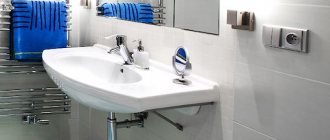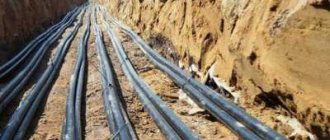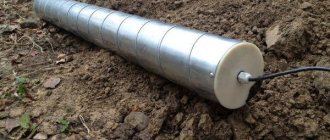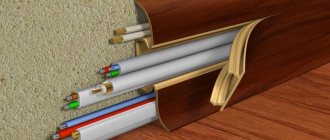There are two main categories of electrical wiring: closed and open. The first involves the installation of communications hidden from human eyes, which eliminates mechanical impacts and guarantees a high level of protection.
Open wiring is the complete opposite of closed wiring: it is less expensive from a financial point of view, labor-intensive and easy to implement, but does not provide adequate protection for the cable from moisture, ultraviolet rays and other damage.
Installation of open wiring requires less labor and financial costs
Open Wiring Requirements
Before installing exposed electrical wiring, be sure to draw up a diagram of the location of the lines and other circuit components, including sockets, switches and junction boxes. Consider a few key points:
- It is strictly forbidden to place lines diagonally. The wires are placed strictly vertically and horizontally relative to the walls, floor and ceiling of the room.
- The cable must be removed from corners and any openings at a distance of at least 150 mm. The minimum installation height for a socket above floor level is 200 mm, for a switch - 600 mm.
- Avoid installing cable lines near heating appliances. Eliminate any heat sources, the impact of which will soon lead to the destruction of the insulating layer and significantly increase the likelihood of an emergency.
- Do not place exposed wiring near pipes. It is prohibited to place pipes at the bottom under which condensation appears.
- When choosing wires, consider the humidity level of the room. For the bathroom and kitchen, the cable must have two or three layers of insulation.
- When connecting several wires, a junction box must be used.
- When drawing up a diagram, you should select a location for the junction boxes in advance. They should be located in an easily accessible part of the room.
Connecting wires in the distribution box
If protective pipes and panels are not used during installation, they should be replaced with special brackets. Their use will prevent the cable from sagging due to its own weight. Two adjacent brackets should be spaced 300 mm apart for horizontal installation (600 mm for vertical installation).
How to choose the right wiring design
For each room, the total load of electrical appliances is calculated. All consumers are divided into groups, each with its own machine installed in the distribution panel. To save wires, external distribution boxes are installed in the rooms, and a group cable from the main switchboard is inserted into them.
If the walls of the house are wooden, install overhead socket boxes
When installing open electrical wiring in PVC cable ducts, models from popular companies are used:
- T-Plast;
- "Ideal Comfort";
- Arbiton.
You may be interested in this IKK Features
Select external electrical installation modules that do not support combustion. The cable and wires are selected based on the load power, the cross-section of the conductor is determined by the total current value.
| Current strength | Copper wire cross section |
| 16 A | 2.5 mm² |
| 25 A | 4 mm² |
Three-core wires are used for connection:
- for socket groups - 2.5 mm²;
- for lamps - 1.5 mm²;
- for ovens, stoves, water heaters, washing machines - 4-6 mm².
Important! Wiring with copper conductors, resistant to combustion and designed for high currents, is suitable for residential premises.
Conductor markings
The brand of wire is chosen taking into account the type of room and installation method.
| Room | Laying method | Characteristics of cable, wire |
| Wet | on roller skates | single-core unprotected wires |
| Dry | on roller skates | twisted two-core wires |
| All types | boxes with opening lids | protected and unprotected single- and multi-core wires, cables in metallic and non-metallic sheaths |
Two types of cables are laid in a house or apartment that meet GOST requirements:
- VVGngLS. Lived from 1 to 5. Insulation, shell made of materials with reduced fire hazard. There is no armored cover. When a fire occurs, there is little smoke and the combustion does not spread. Used for laying in bundles;
- NYMngLS. There is a protective shell, filler, and core insulation. All three layers have fireproof properties. Not suitable for laying in bundles. Easy to clean and bend. Used when installing wiring in corrugated pipes.
There are three brands of corrugated pipe on sale: PVC (gray, white), HDPE (black, orange), PPR (blue). Products made from low-density polyethylene (HDPE) do not contain additives that prevent combustion, so they are not suitable for installing open electrical wiring in an apartment or house. For this purpose, gray polyvinyl chloride corrugation is better; it meets safety requirements and is cheaper than products made from polypropylene (PPR).
| Pipe diameter | Line |
| 16 mm | lighting |
| 20 mm | power sockets |
| 25 mm | on the shield from the distribution box, between the distribution boxes |
Features of installing open wiring
Open type electrical wiring is relevant in cases where the cable is laid above the baseboard, near the joints of walls and ceiling slabs, and in the corners of the room. The selected wire should be as straight as possible. When placing wiring in a room with a false ceiling, the cable is attached to the walls.
If there are a lot of wires, then be sure to use throughput channels. Conductors cannot be placed directly on a suspended ceiling. It was already written above: do not forget about free access to junction and branch boxes.
Laying wires in cable channels
Pros and cons of external wiring
The main advantage of this method is the high speed of installation of cable lines. In just a couple of days, without much experience, you can independently handle the installation of open wiring in an apartment with one living room. A professional electrician will need only a few hours.
The second advantage of the method is its reduced labor intensity. There is no need to groove walls, lay cable ducts or drill holes for socket boxes. Accordingly, there is no need for subsequent installation of cladding, plastering, painting or wallpapering.
The third significant advantage of open-type wiring is constant accessibility to each section of the line. At any time, you can carry out repair work or modify the electrical network by adding new components. This will take a minimum of time and effort. You can quickly and easily add a branch to a new light fixture, connect a new outlet, or move an old switch to another location. When organizing hidden wiring, such work is much more difficult and costly, and is often accompanied by the destruction of walls.
However, there are certain disadvantages in this method. The first disadvantage is that the cable system is in plain sight. Despite the huge variety of different design styles, this approach is not appropriate for every interior. The exception is country, retro, techno and steampunk styles, for which open wiring can be a highlight.
Electrical wiring in a steampunk loft
The second drawback is related to the technical standards of each room where the cable is laid using the open method. For example, for the bathroom, kitchen and other areas with high humidity levels, the wires used should be well protected. The situation is similar with installed switches and sockets. The protection class of such elements when organizing hidden wiring must be at least IP-44. And if we talk about open, then the requirement increases immediately to IP-68. Such wires, sockets and switches look too massive and can ruin the interior in no time.
What you need to install open wiring
Now let's figure out how to choose the right cable, sockets and switches for open-type wiring.
How to choose a cable for external wiring
Similar to the organization of hidden wiring, the choice of cable for external wiring is directly related to the electrical load on the installed system. Household and electrical appliances can function when connected via two- or three-core copper cables or aluminum cables with a cross-section of 2.5 square meters. mm. An electric stove consumes more power, so you will need a cable with a cross-section of 5-6 square meters. mm. The entire branch must be connected to the junction box through a 25 A fuse.
Cable for external retro wiring
Copper cables are considered more reliable and stable, and in some cases the use of aluminum cables is simply unacceptable. This is due to the fact that copper is a material that is more resistant to corrosion and can withstand a greater electrical load compared to aluminum wire of the same cross-section. In addition, copper cable is more flexible, which eliminates the possibility of it breaking even when installing lines with many bends.
Sockets
For open wiring, overhead sockets are used that are attached directly to the wall. There is no need to make recesses for socket boxes, since the contacts of such elements, unlike built-in equipment, are well insulated and hidden inside. If some devices must be used with grounding, you need to buy overhead sockets with the appropriate contact.
Overlay socket block for open wiring
Installation of electrical wiring with pass-through sockets is possible. These are devices where the cable line does not end, but goes further. This equipment is installed using the boxless connection method.
Switches
At this point you should pay attention to sealed switches. They are used for both hidden and open methods of laying electrical cables. For the bathroom, kitchen and other rooms with high humidity levels, the chosen installation method does not matter. Closed devices will prevent short circuits and overheating of the cable. Their installation is similar to an open-type wiring socket: just drill a couple of holes in the wall and securely fix the equipment.
Surface-mounted switches in a wooden house
Methods for constructing underground systems
The most common pipe laying methods are:
- trenchless (laying underground without opening the soil);
- open version (assembly on supports, can be carried out in through or non-through collectors);
- hidden installation method (trenches are prepared along which the pipes run).
The project can be complex or simple. In the first case (usually used for laying water supply pipelines in urban areas using the trench or channel method), several different mains can run in one trench - boxes with cables, a heating network and water supply, for example.
One of the important conditions for the longevity of the entire assembly is the choice of appropriate pipe material. In modern practice, products made of plastic, asbestos, metal (steel, copper), ceramics, and concrete are used.
Open wiring methods
Open installation can be performed using several methods. The choice depends on the type of room in which the installation is performed. In an office, you can use cable channels, but in designer-style living spaces, the wiring is usually hidden under baseboards or other decorative elements.
External wiring in cable channel
The use of cable channels provides several undeniable advantages:
- lack of toxicity of manufacturing materials;
- resistance to elevated temperatures;
- low cost.
Cable channels are placed on the walls and fixed using special glue or dowels. The specific method of fastening depends on the type of surface. The inside of the case is divided into several channels through which different wires can be routed. After laying the wiring, the devices are closed with a special cover.
Installation of external wiring in cable ducts
The channels are supplied with all the necessary plugs and corners. If something is missing, you can always buy it separately. These devices come in different colors, sizes and stylistic designs, so you can find options for both offices and residential premises.
External wiring in pipes
Instead of cable channels, wires can be hidden in electrical pipes, which mainly perform protective and sometimes decorative functions. For example, they are often used when decorating rooms in Scandinavian or loft style. However, this method is more effective when organizing open wiring in a bathroom or other room with a high level of humidity. They provide complete tightness, which cannot be said about cable channels. It is also important to use sockets, junction boxes and switches equipped with additional moisture protection.
External wiring in copper pipes
External wiring with open wire
If you don’t want to hide the electrical cable in pipes or plastic boxes, pay attention to the design of the premises in a retro style. Stores have a variety of electrical and lighting products suitable for retro wiring. You can easily find vintage sockets, boxes, switches, cables with an outer (purely decorative) fabric sheath, and even porcelain insulators used to attach all this to the wall. This design of electrical wiring will look great in country, Provence and shabby chic interiors.
Wiring with an open cable in the interior of an apartment
Wiring through the baseboard
Another option without the use of ducts and pipes is to place the wiring under the baseboard. However, you will have to use a wider baseboard to ensure the presence of several channels. First, the base is installed along the perimeter of the floor. The wires are pulled along special guides made on the baseboard itself, after which they are hidden under the cover. Externally, the plinth is practically no different from the usual one, but you will have to place small plastic guides to sockets and switches. They are small cable channels.
Skirting cable channel with sockets
Types of installation
All methods can be divided into 2 large groups.
- Underground installation. It is used more often and is carried out using 1 of 2 technologies.
- Channelless pipeline installation.
- Underground device in channels.
- Aboveground pipeline laying. It involves installing pipes on the ground surface or at a distance from it (relevant for pipelines above routes, in this case the height of the pipes must be sufficient so that the pipeline does not interfere with the operation of the route). Overhead pipelines are indispensable when the pipe route runs through ravines, transport routes, rivers, and other structures. Aboveground pipeline installation is carried out in channels (trays). They can be located on the ground or be slightly buried in it; this method of installation is relevant in regions with a cold climate, which is characterized by the presence of permafrost soils.
The choice of method for constructing a pipeline line depends on a number of conditions. Among them are planning factors (purpose, intersections of the route with structures and objects), natural (soil category), financial (construction budget) and others (requirements for the aesthetics of the type of engineering system). The decision on technology is made after calculations for various installation options and should be focused primarily on optimizing the cost of communication.
Moreover, the feasibility study should take into account not only the construction price, but also the service component of the project cost. Example - laying a heating pipeline . Choosing an underground device will reduce capital costs for construction. But in maintenance practice, the cost will be higher than that of above-ground installation due to:
- the need for insulation (with ductless installation, heat loss will be higher, especially in wet soil);
- additional ongoing support to prevent early wear.
Where is such wiring prohibited?
Open wiring is strictly prohibited (or additional requirements are imposed on it) in rooms with high levels of humidity and constant temperature changes. These include bathrooms, saunas, steam rooms, kitchens. In this case, you need to use completely sealed pipes. Wires should not be placed openly in large warehouses or in close proximity to explosive objects.
However, sometimes open wiring is the only way to electrify a room. Then you should choose a cable with several insulating layers made of fire-resistant materials. There are also opposite situations: for example, hidden wiring is not recommended in a wooden house.
Despite the complete opposite of hidden wiring, installing an electrical cable using the open method has its advantages, thanks to which it can be used where it is impossible (or not desirable) to hide the conductors. Subject to all operating and safety rules, this method can be used at almost any facility.
Overhead installation
Conditions in which above-ground pipeline installation is justified and effective:
- in an area with heavily icy soils (or underground ice);
- on rough terrain (reservoirs, ravines, residential and industrial facilities, other obstacles along the route that only an overhead installation can overcome);
- high activity of cryogenic processes in the region.
For above-ground installation, pipes made of cold-resistant steel with mandatory insulation are used. For the reliability and safety of the system, it is reinforced with reinforced concrete supports.
Compared to the underground method, above-ground installation ensures high-quality drainage of water (surface), eliminates damage to the environment, damage to soil layers, and simplifies the maintenance of highways. But above-ground installation is not popular due to the cost of construction and maintenance. Pipeline laying work requires extensive experience and highly qualified performers. Added to this is the consumption of expensive materials and strict requirements for calculations.











